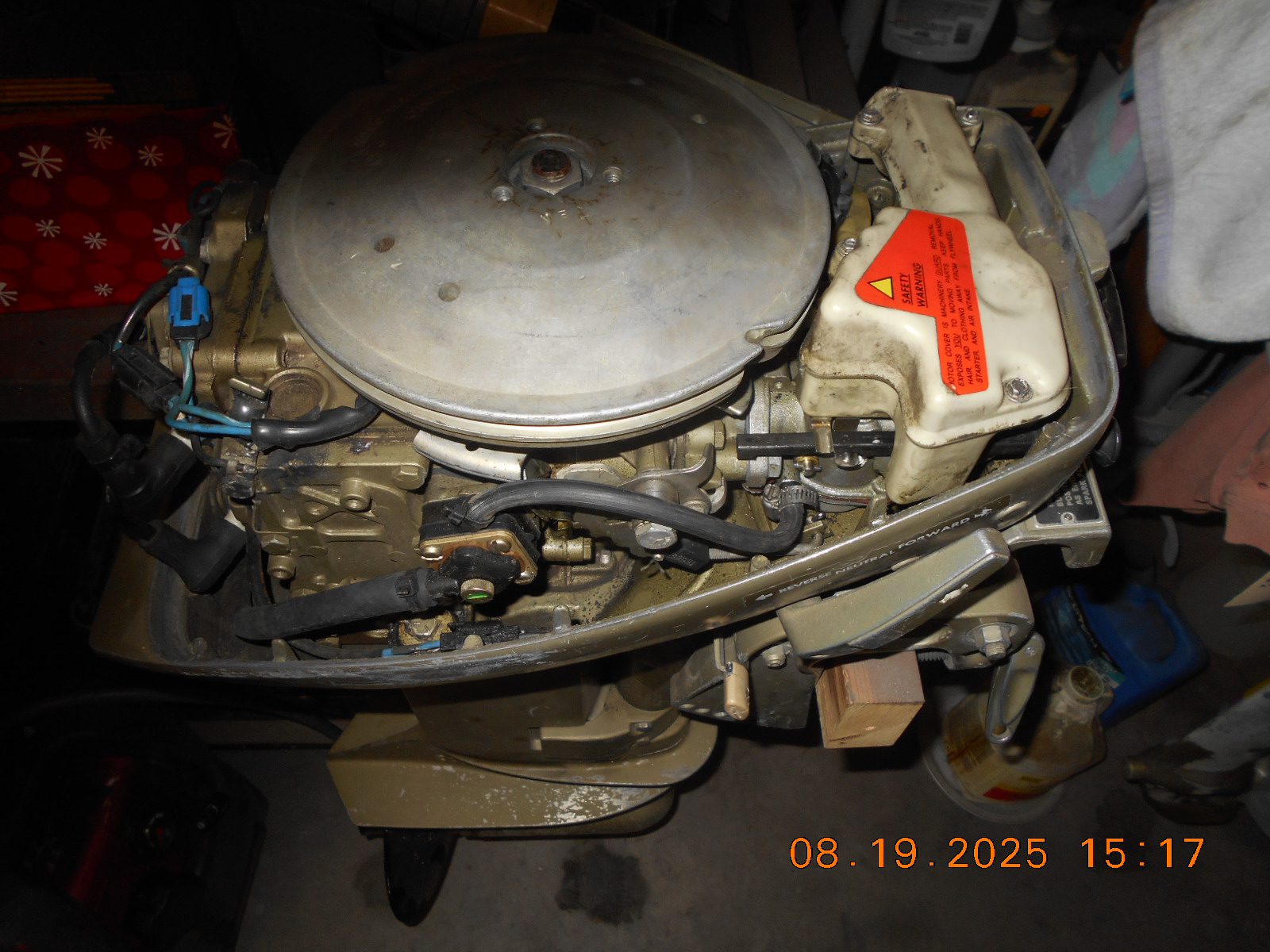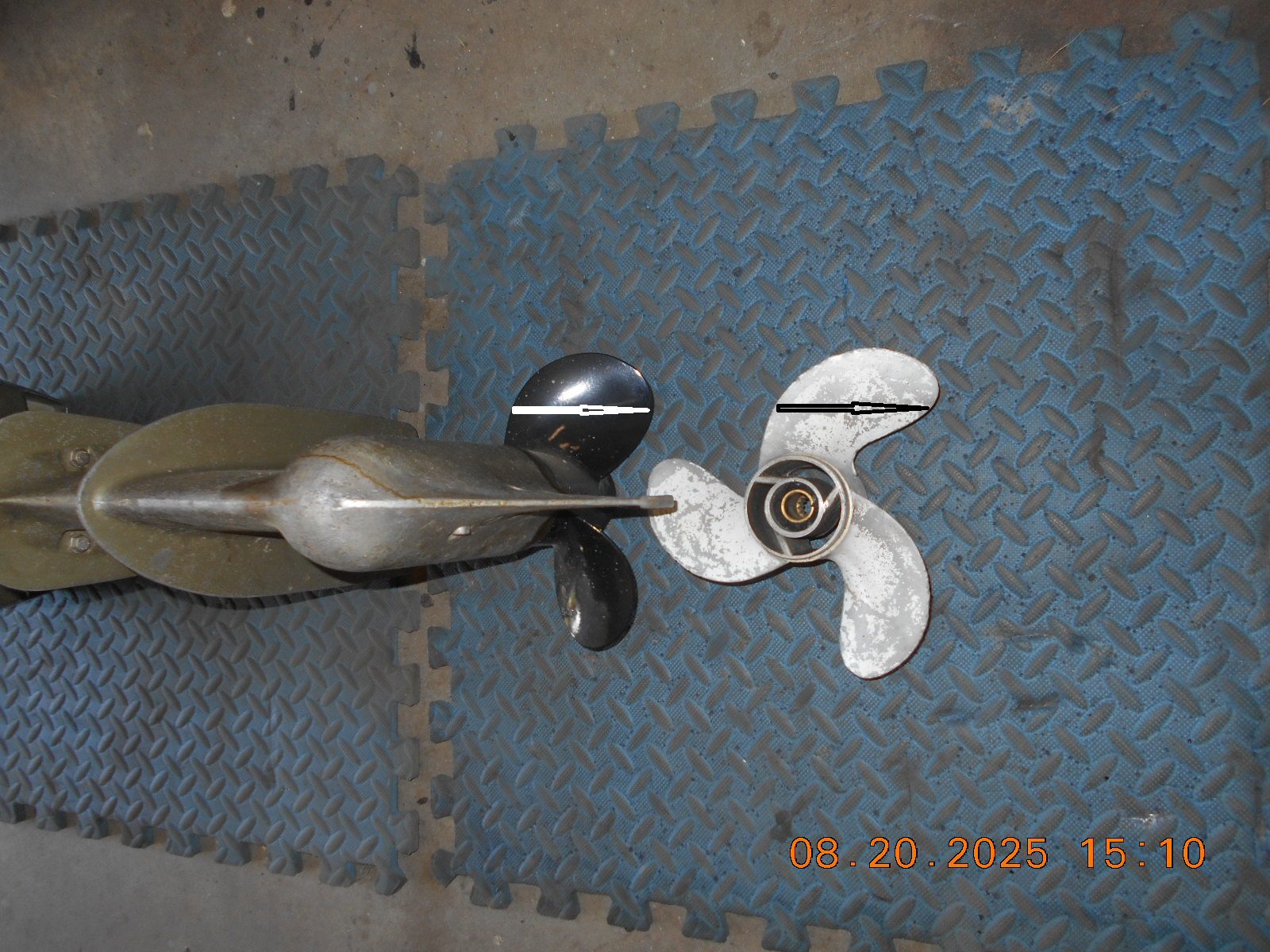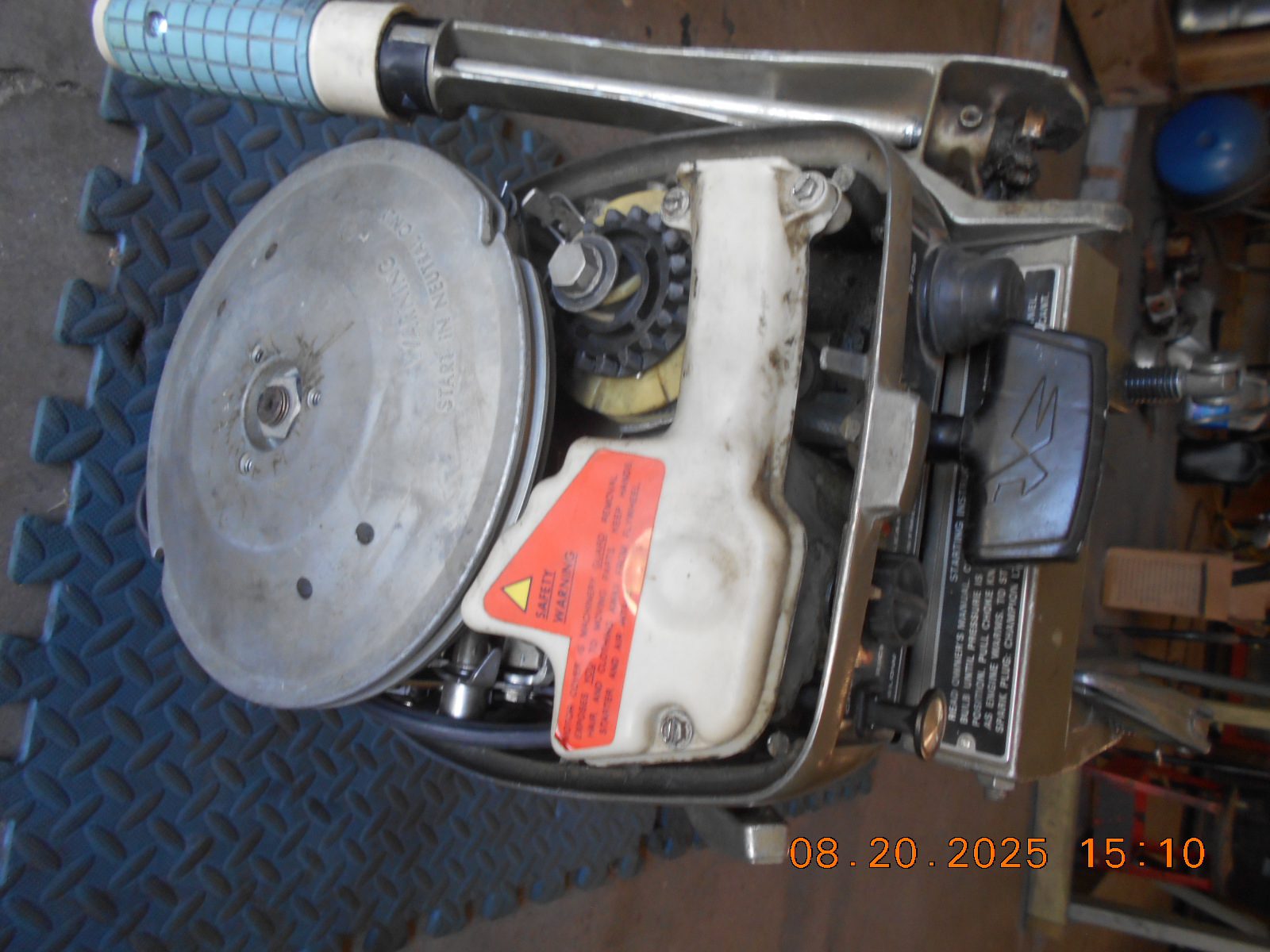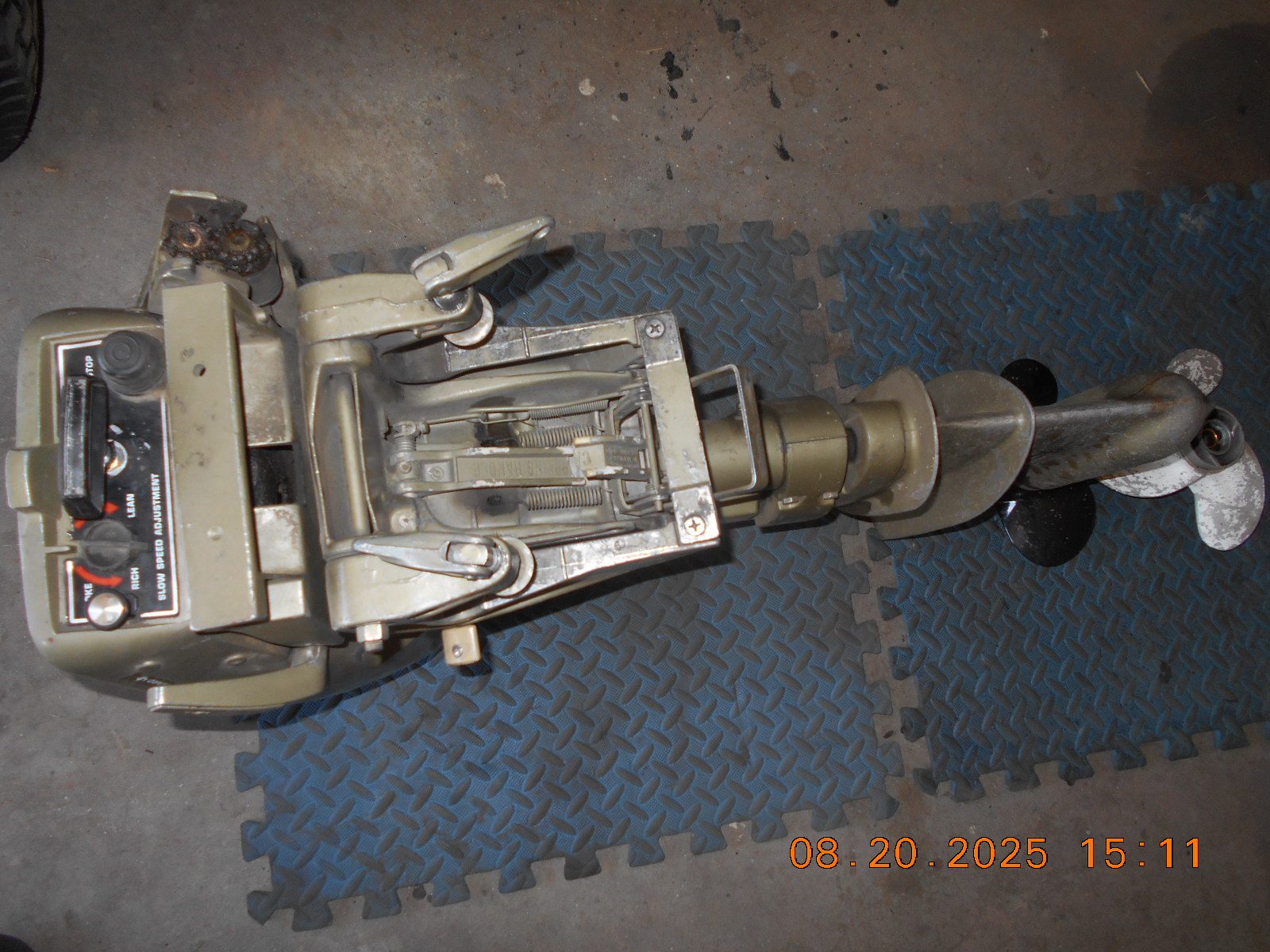Home › Forum › Ask A Member › 1975 Johnson 15R75C 15 hp
- This topic has 33 replies, 8 voices, and was last updated 3 months, 1 week ago by
 Buccaneer.
Buccaneer.
-
AuthorPosts
-
August 20, 2025 at 6:21 pm #299115
My cousin dropped off his kid’s subject motor yesterday,
wondering if I’d take a look at it.
The story was that it was running good, but wound up,
spinning the prop hub.He got a new prop, but then it wouldn’t push the boat at full speed
anymore.
I’m not sure how long between the two events.
Supposedly he tried to adjust the carb to no avail, then
gave up.Not sure if this carb even has an adjustable high speed yet.
I checked the compression today, 93 psi Top, and 89 psi bottom.
It appears to have good spark on each cylinder.I’ll throw it in the test barrel tomorrow to see if it will start.
This 50 year old motor is way newer than I’m used to working on
with this type of ignition system, etc.Anything in particular to look out for in these motors?
Regarding the new prop. It looks to be the same diameter and pitch
just eyeing it up, but the new on is wider across the blades.
How much a difference would this make in top end performance?Prepare to be boarded!
August 20, 2025 at 10:59 pm #299132The white prop blade shape is more of a weedless design. If the pitch is the same, the black one will likely be a tad faster. Pitch is hard to compare by eye when the prop blades are shaped different. They came new with a 10 inch pitch prop.
1974-1976 models have points and condensers under the flywheel, and a pulse is generated that is applied to the external ignition coils that step the voltage up higher yet for spark. No electronic powerpack, as the points control when the spark occurs.
The high speed jet in the carb is fixed – no adjustment. The knob on the front panel is the low speed carb needle. If that low speed needle is adjusted too lean, it will bog an maybe kill if you open up the throttle quickly. Usually have to find best lean idle setting and then advance the knob about 1/4 turn richer to avoid the bog on acceleration – I turn them richer 1/8 turn at a time until the bog is gone. Need to have it on a boat or a test wheel to adjust for bog elimination.
Max RPM range for 1974-1980 is 5500 to 6500 if you have a tini-tach or equivalent to measure RPMs under load. In 1981, a tuned exhaust horn was added inside the exhaust housing, which added another 500 RPM to these numbers and got the HP to 15 at the prop shaft instead of at the powerhead. This was done to compete with imports that measured HP at the propshaft.
Spark plug gap is .030. On 1977 and newer the gap is .040.
The 1974-1976 15s didn’t have a telltale cooling stream, which was added in 1977, but there are youtube videos showing how to add one by drilling and tapping the cylinder’s water jacket.
There is a thermostat on the cylinder head just below the cylinders. In the mid to late 1980s it was moved to the top of the head.
I have never had to dig into the magneto on a 1974 -1976, so can’t offer more help there. I have six similar 15 HPs that I got from a failed resort, but all are between 1979 and 1991.
Dave
August 21, 2025 at 1:09 am #299133I beleive that the way the telltale works on this early version of this style of 9.9/15hp motor is that it will only discharge water out the telltale when the thermostat is open. So once the motor warms up, then the cooling water will apear. That’s just how it works – no need to modify. Simply watch some Chrysleroutboarddude videos on Youtube of ths Johnson 9.9hp and Johnson 15hp versions of this motor with the green lower leg as Ben explains it there. That’s where I learned this from!😁
Also, keep a close eye on the spark plugs for cross-threading when screwing them back in. Due to the orientation of their holes, I find it harder to tell if they’re going in properly than with sparkplugs sticking straight out of a cylinder head.
August 21, 2025 at 8:53 am #299139Thanks for the replies, tips and history of these 15 hp motors!
I’ll try to start it up today in the test barrel, and go from there.
Hopefully it’s just a simple fuel issue, etc.Prepare to be boarded!
August 21, 2025 at 1:11 pm #299142These early versions were a hated due to plug fouling issues and that much hated but misunderstood “low tension” ignition system… This system isn’t all that bad once understood. The key is to make sure the mag plate bushing does not get worn resulting in erratic point gap along with coil magnets hitting the flywheel.
There were several modifications that were supposed to be made to these engines to minimize plug fouling issues, including a new cylinder head. So, if I had to guess here, I’m thinking one of the plugs fouled and it is running on one cylinder. Confirm that the new prop is the same pitch as the one it replaced though.
August 21, 2025 at 5:50 pm #299152Fleetwin, I ran the motor in the test barrel today at the Start
position, in neutral, for about five minutes the first time.
It seemed to be having fuel issues, but if I squeezed the primer
bulb it would straighten out for a while.I raised the fuel tank up higher and it didn’t seem to help much.
Opened up the gas cap in case the vent was plugged, assuming it has one,
and that didn’t do much either.When it died, I felt each plug, and both felt “barely warm”.
Pulled the plugs out, and both looked wet and kind of fouled looking.
I cleaned the plugs up a little, and switched them around, and it ran
about the same.Then put it in gear, and opened it up, and it sounded like it was only
winding up half way. Tried choking it partially to see if it would “pick up”,
and ended up killing it.Decided it was time to inspect things further.
Not sure how much the owner messed with the low speed needle.
What’s the initial needle setting on these motors?Thanks!
Prepare to be boarded!
August 22, 2025 at 10:43 am #299180OK, how about pumping the primer bulb while the engine falters. Seems like it might be having a fuel pump/delivery issue
August 22, 2025 at 5:01 pm #299187My 1973-1990 Clymer shop manual says to back the low speed needle out 7/8 turn. I never looked it up before, and have been doing 1-1/4 turns.
Dave
August 22, 2025 at 5:40 pm #299189OK, how about pumping the primer bulb while the engine falters. Seems like it might be having a fuel pump/delivery issue
As stated above, I did try squeezing the primer while at fast idle
in neutral, and it did seem to help, but when in gear and throttle
wide open, I never did get it to “wind up” very much.
Didn’t get back to it today… other projects, mowing lawn,
and I really need to make another stand to work on it.
This 15 hp motor is a heavy bugger, and I don’t trust my
outboard vise mount, nor do I think I can lift it that
high any more!Prepare to be boarded!
August 22, 2025 at 5:41 pm #299190My 1973-1990 Clymer shop manual says to back the low speed needle out 7/8 turn. I never looked it up before, and have been doing 1-1/4 turns.
Dave
Thanks for the info Dave, that will be good to know!
Prepare to be boarded!
-
AuthorPosts
- You must be logged in to reply to this topic.





